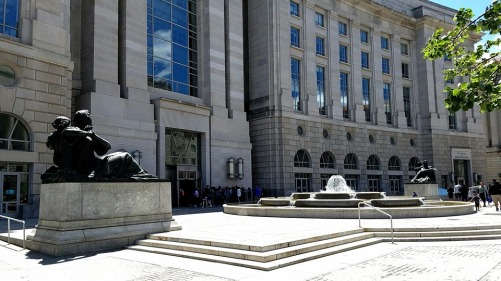
The Oscar S. Straus Memorial
The Oscar S. Straus Memorial is located just two blocks south of The White House, in the Federal Triangle on 14th Street between Pennsylvania Avenue and Constitution Avenue, in front of the Ronald Reagan Building and International Trade Center (MAP), and was the destination of this lunchtime bike ride.
The memorial commemorates the accomplishments of the first Jew to be a member of the cabinet of a U.S. president, having served as Secretary of Commerce and Labor under President Theodore Roosevelt from 1906 to 1909. He also served under Presidents William Howard Taft, William McKinley, and Grover Cleveland, and was offered a cabinet position by Theodore Roosevelt.
Oscar Solomon Straus was born on December 23, 1850, in Otterberg, Rhenish Bavaria, now in the state of Rhineland-Palatinate (now Germany). At the age of two he immigrated with his mother and siblings to the United States, joining their father, Lazarus, who had emigrated in 1852. The family settled in Talbotton, Georgia. At the close of the Civil War in 1865, Straus’s family moved to New York City, where he graduated from Columbia College in 1871 and Columbia Law School in 1873. In 1882, Strauss married Sarah Lavanburg, and they had three children: Mildred Straus Schafer (born the following year), Aline Straus Hockstader (born in 1889), and Roger Williams Straus (born in 1891).
Straus first served as United States Minister to the Ottoman Empire from 1887 to 1889, and then again from 1898 to 1899. In January of 1902, he was named a member of the Permanent Court of Arbitration at The Hague to fill the place left vacant by the death of ex-President Benjamin Harrison. Then in December of 1906, Straus became the United States Secretary of Commerce and Labor under President Roosevelt. This position also placed him in charge of the United States Bureau of Immigration. Straus left the Commerce Department in 1909 when William Howard Taft became president and became U.S. Ambassador to the Ottoman Empire until 1910. In 1912, he ran unsuccessfully for Governor of New York on the Progressive and Independence League tickets. And in 1915, he became chairman of the public service commission of New York State.
The memorial fountain was designed by Adolph Alexander Weinman, and funded with a public subscription beginning in 1929. It was dedicated on October 26, 1947, by President Harry S. Truman. It was disassembled and placed in storage in 1991 during the construction of the Ronald Reagan Building and International Trade Center. After the building was completed, the fountain was reinstalled with all original materials. It was rededicated on October 26, 1998.
In the center of the memorial is the massive fountain with the inscription “statesman, author, diplomat.” To the sides are two statues. The one to the left is one entitled Justice, which depicts a woman representing “Justice,” with her arm resting on the Ten Commandments. It is intended to symbolize the religious freedom which allowed a Jew to serve in such a position of authority. The inscription on this statue reads, “Our Liberty of Worship is not a Concession nor a Privilege but an Inherent Right.” To the right of the fountain is the statue entitled Reason. It depicts a partially draped male figure and a child holding a purse, key, and hammer, symbolizing the capital and labor efforts put forth by Straus throughout his career.
Straus died on September 3, 1910, and is buried at Beth El Cemetery in Ridgewood, New York. For more on his life and career, you can read his memoirs, entitled “Under Four Administrations,” which he wrote and published in 1922.
[Click on the photos to view the full-size versions]
























































